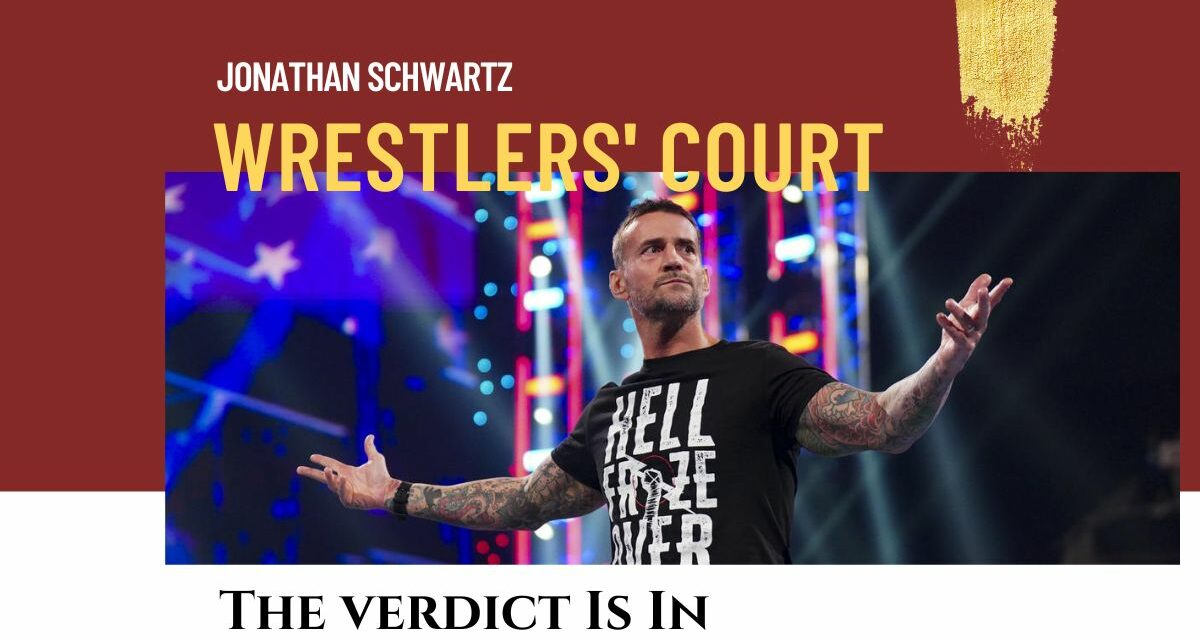In my last column I discussed CM Punk’s return to WWE after a nine-year absence. I focused on the issues that led to Punk’s departure, his fans continued hope for his return and the circumstances that brought him back to the recent Survivor Series Premium Live Event. I also tried to sketch out a plan for this return that will maximize Punk’s value and hopefully make for a happy reunion between the wrestler, the promotion, and the fans.
Much has been written about Punk’s estrangement from WWE. Even when relations between those parties were non-existent, in our collective fandom we believed that, somehow, someday, somewhere he would come back. And why wouldn’t he? The weight of precedent made Punk’s return a near-certainty.
As I started writing I thought about other WWE headliners: champions who had fallen out of Vince McMahon’s favor and spent years outside the WWE umbrella, only to be welcomed back once enough time had passed. A quick review captures almost every single significant champion in WWWF/WWF/WWE history from Bruno Sammartino through Punk himself. Even Dwayne ‘The Rock’ Johnson had his disagreements with WWE, leading him to a recently revealed distancing. In fairness, The Rock has been busy enough that we barely noticed, and those fences were swiftly mended.
To keep this column at least slightly shorter than novel length, I will hold off some more recent returns. ‘Stone Cold’ Steve Austin, Brock Lesnar and Bill Goldberg have all had their ups and downs with WWE, walking out or being cast out of the company.
I exclude Lesnar and Goldberg because they simply opted not to renew their contracts after they expired. Both men admitted to burning out over WWE’s schedule and poor booking choices, leading to extended absences.
Goldberg held out until 2016. On his return he revisited his program with Lesnar, starting with a shocking blowout win at Survivor Series in Toronto.
Both men won multiple world championships on their returns, working light schedules and for the most part limited matches. They became special attractions with their appearances geared towards WWE’s biggest shows of the year.
Lesnar has become a legend in his second run. He ended The Undertaker’s WrestleMania undefeated streak and became a championship fixture. At one point he held the Universal Championship for over a year, displacing CM Punk in the modern record books (with Roman Reigns’ three-year-plus title reign, it is unlikely that Punk will take that record back).
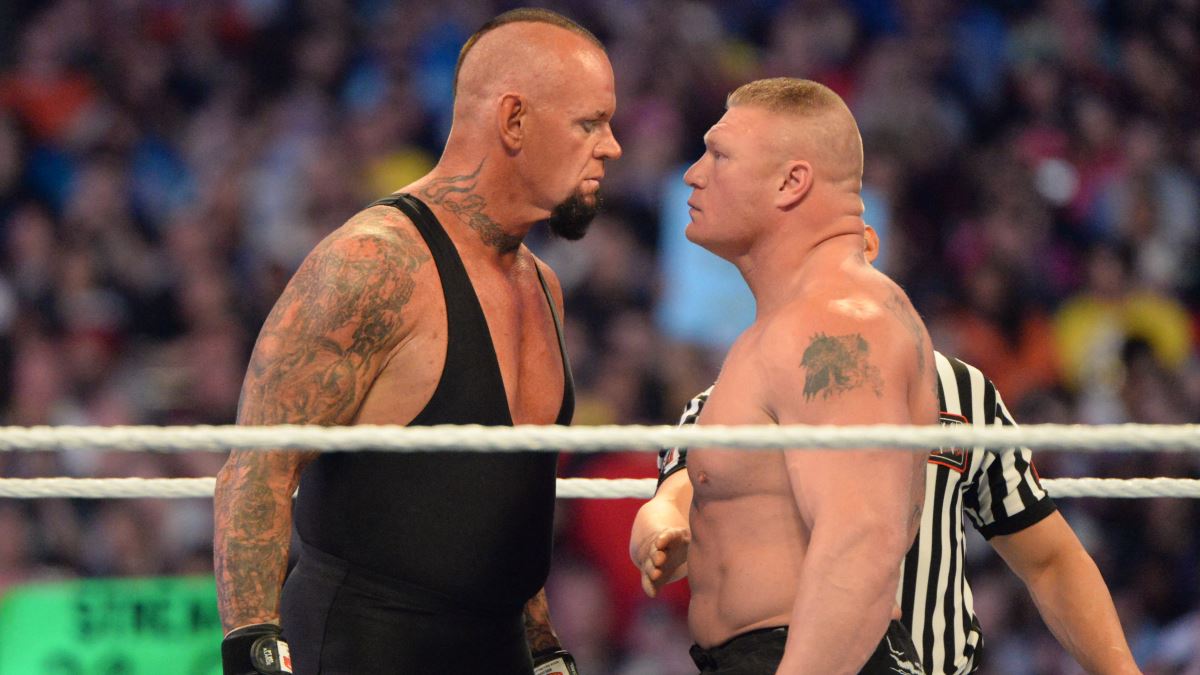
The Undertaker against Brock Lesnar at WrestleMania XXX. WWE photo
Goldberg notched a pair of Universal title wins as well. He worked more sparingly than Lesnar and came back older and longer removed from the wrestling world. His shortest matches have been his best. Still, I think that he has given WWE fans the Goldberg that they wanted to see. After being mishandled during his first run he was booked properly as a monster in his second go-round and responded with a better attitude and more fun performances (even if some wound up pretty ragged). If Goldberg never steps into a WWE ring again I believe that he has vastly improved his standing. I’m sure Bret Hart disagrees.
Austin is out because his absences, prompted by exhaustion and dissatisfaction over his character’s direction, were short and his return was a victory lap before injury forced him to retire. It seems odd to think of Austin’s short-lived disagreements in the scope of his WWE career. Austin has been a recurring character on WWE broadcasts since his retirement even if his in-ring activities have been limited, and he still sells a ton of merchandise.
Here are the best comparators, in my view:
BRUNO SAMMARTINO
Bruno Sammartino was one of the longest holdouts. One of the WWWF’s earliest and by far its most important champion for the Fed as a regional promotion, he still holds the record for longest individual WWWF World championship reign at seven years. Bruno gave up the title due to injury and the desire for a lighter schedule but was lured back for a second nearly four-year reign. Sammartino’s success established the WWWF as a significant player among the territories and helped build the resources that eventually fuelled the WWF’s national expansion.
Most fans believe that Bruno fell out with the WWF over his distaste for Vincent K. McMahon’s crass and cartoonish presentation of professional wrestling. Bruno’s grudge had deeper roots. After initially retiring from professional wrestling in 1981, Bruno was contacted by a disgruntled former employee of Capitol Wrestling Corporation (CWC) — the forerunner of WWE — and advised that he had been shorted on payouts for the entirety of his second title run. Sammartino sued Vince McMahon (the father) and CWC for the money he was owed. The suit was settled by Vince the Younger after his father’s death.
The younger McMahon may have considered Bruno’s goodwill invaluable as he built the WWF from a local territory (albeit one that captured some of the largest media markets in the country) into a national and eventually international powerhouse. Even a retired Sammartino was important enough that as part of his settled lawsuit he would return to the WWF as a color commentator.
Bruno was coaxed back into the ring after the first WrestleMania to support his son David’s wrestling dreams. This didn’t work out so well. It turns out that David chose a pro wrestling career over Bruno’s objections. David soon found that his own value was limited to his famous father’s participation in his matches. Relegated to enhancement status on his own, David called an audible and lost to ‘jobber’ Ron Shaw on purpose, leaving the WWF in early 1986. After Bruno refused David’s pleas to form a tag team in an effort to improve David’s spot, father and son had a significant falling out. They were estranged for the rest of Bruno’s life.
In the meantime, as a defiantly old-school babyface whose commentary and interviews were heavy on ‘aw shucks’ and ‘doggone it’ reactions to flagrantly cheating heels, the elder Sammartino was brought into feuds with emerging stars like Randy Savage, Roddy Piper and ‘Adorable’ Adrian Adonis. Bruno’s last WWF match occured in August 1987 when he teamed with Hulk Hogan to beat King Kong Bundy and the One Man Gang.
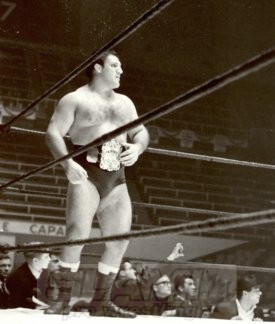
WWWF World champion Bruno Sammartino in Toronto. Photo by Roger Baker
Bruno returned to the commentary desk until leaving the WWF altogether in 1988. He has often claimed credit for other champions’ success. He has stated that without his presence as a co-main event or on the undercard, subsequent champions Pedro Morales, Bob Backlund and Hulk Hogan would not have drawn nearly as well as they did with him.
As soon as Bruno left the WWF he became a gadfly. After building his own legacy as a powerful, pre-steroidal strongman he was sharply critical of the WWF’s embrace of performance-enhancing drugs and what he saw as the vulgarity of WWF storylines. Sammartino was muted by the WWF’s penchant for erasing its territorial, pre-Hogan history — which could not have sat well with Bruno. In a pre-streaming world, Bruno became a fixture on daytime talk shows and emerging news-only networks desperate for content.
It took 25 years for Bruno Sammartino to end his estrangement from the now-WWE.
In 2013 Sammartino agreed to be inducted into the WWE Hall of Fame. Current WWE Head of Creative Paul ‘Triple H’ Levesque made multiple attempts over the years to secure Bruno’s involvement, as he was a glaring omission from the Hall. Levesque acted as peacemaker between Bruno and Vince McMahon. He persuaded Bruno to ‘come home’ since WWE had abandoned the excessive vulgarity of the Attitude Era (debatable) and clamped down on performers’ drug use (also debatable).
When Sammartino returned to WWE he was 78 years old and fully retired. He was inducted into the Hall of Fame by Arnold Schwarzenegger (himself a fan, who identified with Bruno as a bodybuilder and a working class immigrant) and made a couple of appearances on Raw and at house shows in his hometown of Pittsburgh. A bronze statue in Sammartino’s honor was cast in 2014. Bruno did the honors in 2015, inducting protégé and opponent Larry Zbyszko into the WWE Hall of Fame.
‘SUPERSTAR’ BILLY GRAHAM
Much has been written about Superstar Billy Graham’s career and his complicated legacy within sports entertainment. His alienation from the then-WWF is notable because it encompasses multiple episodes.
I’ve never quite understood the level of rancor.
Graham achieved peak notoriety as a wrestler when he beat Bruno Sammartino for the WWWF title in 1977. If you’re enough of a wrestling fan to have read this far, you know the story. Graham, a popular and charismatic heel, was told when he entered the WWWF that he would win the title, hold it for several months, then lose it to Bob Backlund as the next long-term babyface champion. Graham’s reign was a departure from the WWWF’s established formula. To that point, heels were only transitional champions whose reigns had been measured in days or weeks. Graham was transitional too in the sense that he knew how long he would be champion to the day.
Graham proved a popular champion despite his heel status. He believed that he could make more money for himself and the WWWF if he turned babyface and continued to hold the title beyond his promised term. He may have been right. Hulk Hogan based much of his character on Graham’s and went on to his own legendary run. Vincent J. McMahon had already promised the belt to Backlund and stuck with his original plan.
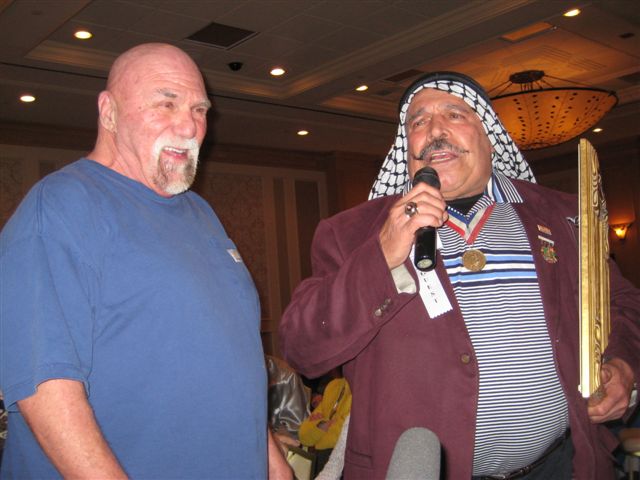
Superstar Billy Graham and the Iron Sheik at the 2009 Cauliflower Alley Club reunion. Photo by Howard Baum
To hear Graham talk about it he was destroyed by this loss; it stuck with him for the rest of his life and was the subject of frequent social media postings. He sharply critical of Backlund and has often told of falling into a deep depression and self-medicating to deal with the pain of his title loss. I don’t think he ever completely recovered.
There are plenty of athletes whose careers and lives become haunted by a loss or a bad play, but those results aren’t predetermined — at least part of their suffering stems from their own perceived failure. I get that the title loss impacted Graham’s ability to draw an audience and the size of his paychecks, but while fans still believed in kayfabe, Graham was certainly smart to the business.
Notwithstanding Graham’s disappointment over the length of his title reign and refused face turn, he came back to the WWF for two shorter stints: as a bald, clinically-depressed martial artist to challenge Backlund in 1982-83, and for an intended victory lap as a tie-dyed bodybuilding babyface in 1986. By this time his body was starting to give out from years of steroid and other drug abuse.
Like Sammartino, Graham became a vocal WWF detractor. I always felt his criticisms came from a different place than Sammartino’s. While Bruno was offended by wrestling’s increasing reliance on drug-fueled physiques and cartoonish, crass storylines, one could argue that Graham laid the foundation for both. He created the smack-talking bodybuilder archetype which still plays today.
I think that the ‘Superstar’ character was so successful that it’s become a prerequisite for most wrestlers to succeed, especially in WWE. Less-conditioned wrestlers are now the standouts, while most of the roster from enhancement to main event boast nice pecs and six-pack abs. Graham’s accusations seemed more fueled by bitterness that despite his trailblazing persona he never got his due. What followed would be a series of disputes and reconciliations, often timed to when Graham sought the benevolence of his former employer.
Graham was a persistent thorn in the WWF’s side. In 1992 he appeared alongside Vince McMahon as part of a panel on The Phil Donahue Show. Graham alleged that he saw senior WWF personnel sexually abuse children. He persisted in these allegations which included former friend and tag team partner Pat Patterson. Much later, Graham admitted that these claims were false, an attempt to extort a payout from WWE. An apology letter followed which was ignored by McMahon until after Graham received a life-saving liver transplant in 2002.
In 1994, Vince McMahon was tried for steroid distribution following physician Dr. George Zahorian’s 1991 conviction under the US federal Anti-Drug Abuse Act. Concurrently, Graham sued Zahorian and the WWF alleging that they compelled him to abuse steroids as part of his job. This lawsuit failed for several reasons, chief among them the fact that Graham had been an avid steroid user well before he started wrestling.
Graham wouldn’t reconcile with the WWE until 2004, when he was inducted into its Hall of Fame by Paul Levesque. In carny desperation he sold his Hall of Fame ring to pay for anti-rejection medicine to support his transplanted liver. He wrote an autobiography and had a DVD produced about his life and career under WWE’s imprint in 2006, leaving again in 2009. Graham launched another tirade against WWE and its Hall of Fame after Abdullah the Butcher was inducted. Graham argued that Abdullah didn’t deserve the honor since he had never wrestled for WWE in any of its incarnations. Graham’s vitriol was more likely fueled by his relationship with wrestling hanger-on Devon ‘Hannibal’ Nicholson, who had sued Abdullah for allegedly giving him Hepatitis in a match.
Graham’s adversarial stance persisted through Linda McMahon’s 2010 Senate campaign. He called out McMahon’s hypocrisy in playing down her role in WWE’s adult-oriented programming to further her political ambitions despite profiting from pro wrestling sleaze. Graham changed his tune as his health deteriorated, going so far as to publicly seek a spokesman’s role with the campaign.
And you think giving Punk a live microphone is a risk.
Graham was back in the fold by 2015, He signed a Legends deal which he re-upped in 2021. He passed away after more than a decade of ill-health in May 2023.
HULK HOGAN
Compared to Sammartino’s and Graham’s beefs, Hulk Hogan’s partings from WWE are mild and generally more business or public relations-based than they are personal. Towards the end of Vince McMahon’s run at the helm of the company, he even tried to bring Hogan back in an ambassador role — a move that many wrestlers and fans rejected for reasons set out below.
Hogan was the public face of the WWF’s 1980s expansion. He still holds the record for the most WrestleManias headlined and was one of the lynchpins of McMahon’s attempt to take pro wrestling mainstream. Born in the AWA, Vince’s transplanted version of ‘Hulkamania’ was synonymous with wrestling for years. By the early 1990s the act had run its course. Hogan’s superheroic antics became repetitive. Kids who worshipped him aged out of their fandom. The younger siblings who followed made Hogan less cool.
Worse, a series of scandals tarnished the wholesome image that Vince McMahon had sought to craft for his ‘sports entertainment’ empire. Hogan himself was implicated as a steroid abuser and made matters worse when he publicly lied about it, including during an appearance on The Arsenio Hall Show. He took an extended hiatus from the WWF following his WrestleMania VIII victory over Sid Justice and returned in early 1993, coincidentally sporting a much leaner, smaller physique. Add a WrestleMania IX appearance where he dropped in for a regressive, last-minute WWF Championship victory that stole Bret Hart’s thunder and it was clear that Hogan was no longer best for WWF business.
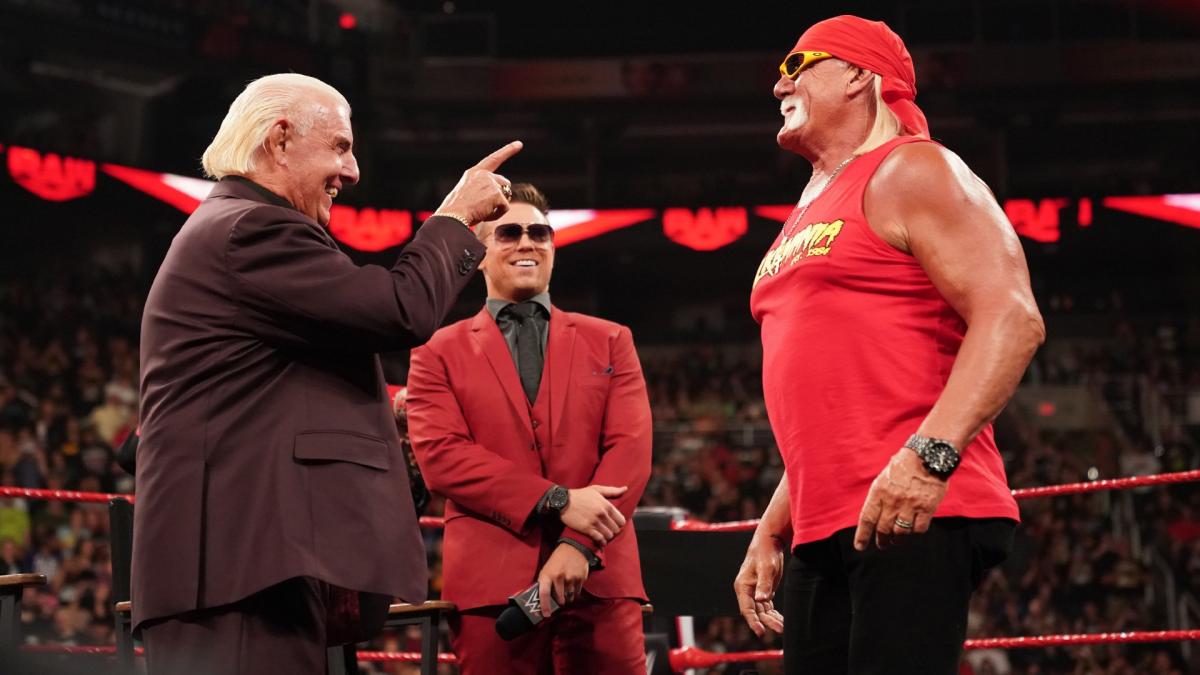
Ric Flair, The Miz and Hulk Hogan in a WWE ring. WWE photo
By mid-1993 Hogan would leave the WWF. He initially attempted to leverage his wrestling recognition into an acting career. He produced and starred in his own syndicated action show vehicle, Thunder in Paradise, but was drawn back into wrestling within a year. He wrestled several shows for New Japan Pro Wrestling (NJPW) and became one of Eric Bischoff’s first ‘gets’ as part of a rebuilding World Championship Wrestling (WCW) franchise. Bischoff saw value in Hogan’s persona. He offered Hogan a lucrative contract and creative control to an otherwise aging superstar. As a sidenote, while employed by WCW, Hogan testified at Vince McMahon’s steroid distribution trial about his past drug use. After being granted immunity from prosecution Hogan admitted to using steroids although he “believed they were legal” since he had obtained a prescription for them. Hogan further stated that he had the drugs mailed to a post office box at WWF headquarters, along with his paycheck and fan mail. Despite grave concerns from Vince McMahon’s camp, Hogan refused to implicate his former boss. He denied the state’s key allegations that McMahon supplied him with steroids or compelled him to use them as part of his continued employment with the WWF. It is believed that Hogan’s testimony was a critical factor in McMahon being found not guilty.
Hogan was put over strong in WCW. He won the WCW World Heavyweight Championship in his first match and plunged into an extended feud with Ric Flair — the same feud that fans demanded but McMahon failed to execute during Flair’s first WWF run. The initial buzz caused by Hogan’s defection would subside as fans quickly grew tired of an already-stale act. Hogan rejuvenated himself and the wrestling business with his 1996 nWo heel turn. The children who had left training, prayers and vitamins behind had become teenagers or college students and rediscovered Hogan in his new bad guy persona.
Hogan was a key figure in WCW until shortly before its demise, when he exited the company after a dispute with head writer Vince Russo. Like many WCW headliners he would sit out the remainder of his contract and return to the WWF in 2002-at first as part of the nWo (also featuring the WWF returns of Scott ‘Razor Ramon’ Hall and Kevin ‘Diesel’ Nash) until his WrestleMania X8 match against The Rock turned him babyface for good. Hogan notched a short WWF Undisputed Championship reign and was featured in storylines that boosted younger talent like Brock Lesnar and Kurt Angle. He left WWE again in 2003 citing his dissatisfaction with a storyline that put him under a mask as Mr. America and disappointment over his payouts.
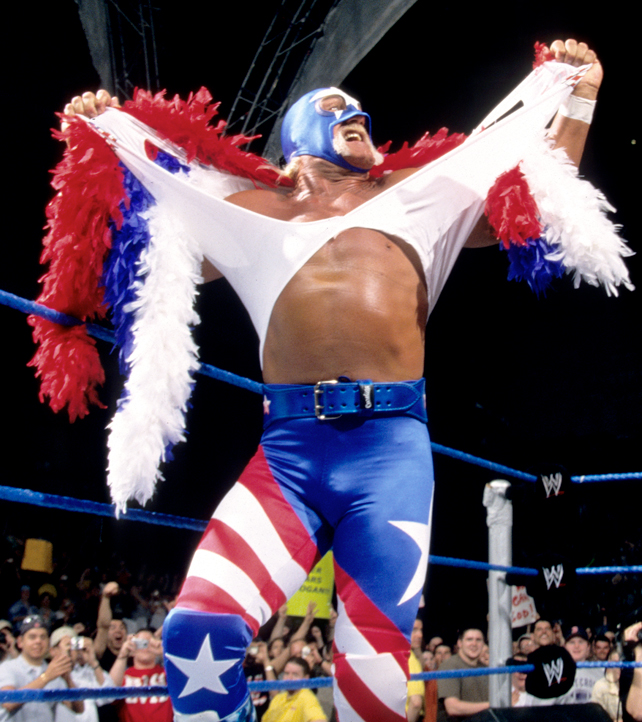
Hulk Hogan as Mr. America.
This exit established a cycle of shorter runs punctuated by Hogan’s 2005 enshrinement in WWE’s Hall of Fame and a cameo appearance at WrestleMania 21 where he revisited his jingoistic trouncing of the Iron Sheik by beating up Muhammad Hassan and Khosrow Daivari. After a sojourn to TNA as a storyline co-owner and heat-sucking manager of his own faction of wrestlers, Hogan, who by this time could no longer wrestle due to a lifetime of back injuries, returned to WWE in 2014 to hype the nascent WWE Network and host WrestleMania XXX.
While Hogan’s previous comings and goings reflected his and WWE’s business interests, in July 2015 Hogan was dismissed from his latest WWE contract. The National Enquirer and Radar Online published horribly racist and homophobic remarks that Hogan had made during a clandestinely-recorded sex tape. Hogan apologized in an attempt to mitigate the damage to his reputation but it was too little, too late. Hogan didn’t help himself. For years following the tape’s release he said that the issue was less the incendiary nature of his remarks and more the fact that he got caught. Like countless less-notable wrestlers before him, Hogan was scrubbed from WWE history … at least for a little while. He disappeared from the ongoing season of Tough Enough. His merchandise was pulled from WWE’s online shopping portal. He was removed from WWE’s Hall of Fame webpage and video games that were in development.
Hogan’s absence from the WWF was relatively short but notable in that it was driven by a promoter seeking to protect its reputation from the hateful remarks of a former top star. By 2018 Hogan’s Hall of Fame webpage was restored and he was invited backstage at WWE events. He appeared on-screen again towards the end of the year as the host of the Saudi Arabian Crown Jewel pay per view (a relatively low-risk appearance since Saudi government representatives were generally more aware of WWE’s history than its present). Subsequent appearances have been limited to Hall of Fame inductions, tributes to colleagues after their passing, and occasional angles. Attempts to feature Hogan more prominently have mostly backfired. While WWE remains invested in Hogan and his character audiences have proven less forgiving. Hogan co-hosted WrestleMania 37 with Titus O’Neil, who is Black and has transitioned from a mid-card in-ring talent to a highly influential brand ambassador. O’Neil himself had been critical of Hogan following his remarks. He indicated that he has since forgiven the Hulkster but it’s clear that the relationship between Hogan and the WWE remains somewhat distant. At this point Hogan stands for the proposition that one can certainly forgive all manner of indiscretions, but there are some things one cannot forget.
BRET ‘HITMAN’ HART
The circumstances surrounding Bret Hart’s eight-year estrangement from WWE are some of the best documented and most public of the stories listed here. It’s a tangled web, with parts captured between the documentary Hitman Hart: Wrestling with Shadows, Bret’s autobiography Hitman: My Real Life in the Cartoon World of Wrestling, an A&E Biography, WWE DVDs, a Calgary Sun column and plenty of print and video interviews. I’ll presume most of you know the detailed version.
In a nutshell, Bret’s exile from and return to WWE is the most personally affecting and multi-layered of these stories. He was treated poorly on his exit from the company, which was precipitated by Vince McMahon’s buyers’ remorse over signing Bret to a long-term contract at a time when WWE business was down while WCW was surging.
Bret opted to take a lower-paying, longer term deal with WWE out of loyalty to that promotion, instead of a shorter-term more lucrative offer from WCW, which at the time was raiding WWE talent like the McMahons had done to the territories a decade or so earlier. Within a few months McMahon broke the contract he signed with Hart, then refused to honor the terms of the deal he’d struck with Bret on his way out. Without telling Bret first, McMahon overrode Bret’s creative control in losing the WWF Championship in the ‘Montreal Screwjob’. It was a bad piece of business even if it was one that changed the nature of professional wrestling to this day.
Some fans argue that the Screwjob was an inside job. Personally, I think it was a real as pro wrestling gets, especially for Bret. Wrestling has always been a bit more real for Bret than for other performers, and that’s part of what made Bret compelling as a performer. Of course title wins and losses are predetermined. As fans we have become jaded by insiders’ insistence on calling this fact out at every turn. Outing championships as plot devices has long hurt our ability to suspend disbelief and must be galling for wrestlers like Bret who worked so hard to make matches and programs look and feel ‘real’.
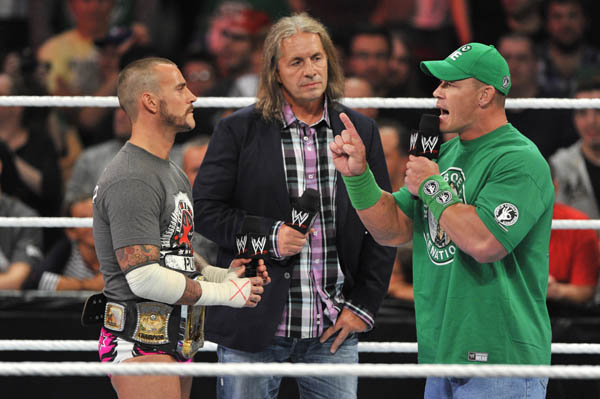
Bret Hart, with CM Punk and John Cena in the Bell Centre in Montreal in September 2012. Photo by Minas Panagiotakis
I think from Bret’s perspective he was legitimately double-crossed. He was denied a contractually agreed upon sendoff. WWE’s decision to revoke Bret’s contract took long-term money out of his pocket, which was exacerbated when WCW refused to honor Bret’s contract there following a concussion sustained in-ring and the failure of WCW’s medical staff to address the issue appropriately. Add in the lingering ill-effects on Bret’s health, a line through which can also be drawn from his WWF exit, and one can see how badly Bret would have been affected financially, physically, emotionally and psychologically. Bret has also admitted to feeling incredible guilt over his brother Owen’s death in 1999 from a WWF pay-per-view stunt gone horribly wrong. That event wreaked further havoc on the Hart family as they divided over how to handle the tragedy. Bret split with some less-famous siblings who argued for a more opportunistic approach. To this day Owen Hart’s widow Martha refuses to have anything to do with WWE — or most of the Harts.
Bret reconciled with the now-WWE between 2004 and 2005. He has said that relations began to improve after Vince McMahon called him in hospital while Hart recovered from a stroke. Hart’s image was licensed to a 2004 video game and he worked with WWE, sitting for interviews and selecting footage for a 2005 DVD career retrospective. He was inducted into WWE’s Hall of Fame in 2006 solo (and again in 2019 as part of the Hart Foundation tag team alongside the late Jim ‘The Anvil’ Neidhart in a ceremony that was waylaid when some idiot tackled Bret and niece Natalya in the ring).
Hart’s return to an on-camera role has necessarily been limited. After suffering a career-ending concussion at the boot of Goldberg (about which he is still vocal on social media) and a stroke in 2002 he has largely recovered but cannot be medically cleared to wrestle. He has also acknowledged that some effects of the stroke have persisted which affect his ability to perform physically and vocally. Still, WWE has tried to find roles for him. Hart formally re-signed with WWE in late 2009 and appeared on RAW to publicly settle his longstanding feud with Shawn Michaels. At WrestleMania XXVI he ‘fought’ Vince McMahon in a no holds barred match that turned into an excessively long Hart family beatdown. The match was terrible, but it may have been cathartic for all involved. He won the WWE version of the US Title from The Miz in May 2010 and vacated it shortly thereafter. Bret followed this with a brief stint as RAW General Manager during the early days of the Nexus storyline. His contract expired in November 2010 although he still shows up occasionally on WWE and other promotions’ shows.
Taken together, if anyone had reason to hold a lifetime grudge against Vince McMahon and WWE it is Bret Hart. The fact that he’s put such an acrimonious split behind him may speak to the usual financial incentives, but I choose to take Bret’s word that he was willing to thaw relations because of the rare kindness McMahon showed when Bret was sick and the desire to protect his legacy, virtually all of which is housed in WWE’s video archives. I understand letting business bygones be bygones. I would have greater difficulty with the circumstances of Owen’s passing, but I know that I cannot put myself in Bret’s boots. In deciding to mend fences with WWE Bret likely understood how earlier champions had been erased — or worse, had been demeaned by WWE’s ‘history is written by the victors’ mentality. The Ultimate Warrior was buried in one DVD entitled The Self-Destruction of the Ultimate Warrior and sued over it before he returned to the fold. The DVD that Bret wound up working on was initially going to be titled Screwed, eschewing a decade of matches and a career as a hero in favor of the lousy story of his departure. Owen was part of that broader legacy too. Despite Martha’s understandable refusal to be involved with WWE, Bret’s return preserves a more favorable place for the Harts in wrestling’s pantheon.
ULTIMATE WARRIOR
A 2017 New York Post article entitled Behind Ultimate Warrior’s WWE exit: Betrayal, jealousy and $500K sets out the circumstances of the enmity between Warrior and the WWF. The article traces the issue to 1991, when Warrior was a massive star and positioned as a potential successor to Hulk Hogan as the Federation’s franchise player. Warrior beat Hogan for the WWF World Heavyweight Championship at WrestleMania VI in April 1990. He was poorly received by audiences as champion. He lost the title to Sgt. Slaughter (more on him later, maggots!) at the 1991 Royal Rumble, who in turn rode his nuclear heat-generating Iraqi sympathizer gimmick to a transitional reign before dropping the belt to Hulk Hogan at the next ’Mania. Warrior would nominally stay in the main event picture. He teamed with Hogan at SummerSlam 1991 to defeat Slaughter, his manager General Adnan and the mysterious, heretofore unknown threat known as Colonel Mustafa.
Offscreen there was tension between Hogan and Warrior, and more importantly between Warrior and WWE head Vince McMahon. SummerSlam marked Warrior’s last WWE match for seven months. It turns out Warrior disappeared because he had long been dissatisfied with his paycheck and leading up to SummerSlam threatened to no-show the main event of the WWF’s second-biggest show of the year unless Vince anted up an extra $500,000. Warrior further sought a guarantee that he be paid the same as Hogan, and perks like guaranteed days off. McMahon relented, then suspended Warrior immediately after the show.
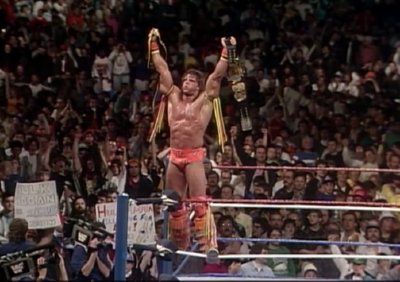
Ultimate Warrior at WrestleMania 6 in Toronto.
Warrior allegedly refused the suspension and tried to quit, which WWE refused to accept. Warrior’s contract ran through September 1992. This period included a botched run-in to save Hulk Hogan from a beating by Papa Shango and Sid Justice in one of the main events of WrestleMania VIII. He left the company in November, having failed a drug test at a time when the WWF was cracking down on steroid use in the face of Vince’s federal indictment. He wouldn’t be seen in wrestling circles until 1996. True to form, the WWF saw value in another run as WCW surged in popularity and WWF business stalled. Warrior’s biggest splash was a squash of Triple H at WrestleMania XII but he’d be gone shortly thereafter following a string of no-shows.
I’ve often wondered whether Levesque’s reputation for brokering the return of prodigal superstars is somehow rooted in his early experience being used to get Warrior over to no good end.
Warrior and the WWF spent the next few years suing each other. Warrior, who had legally changed his name in 1993, won the intellectual property rights to ‘The Ultimate Warrior’ — which is funny, since ‘Bad News’ Allen Coage had used the same moniker for years before joining the WWF. He also settled a claim relating to a burial of a WWF ‘documentary’.
But time and money and exposure heal all wounds. 18 years later, Warrior reconciled with the now-WWE and was inducted into the Hall of Fame at WrestleMania XXX. He gave a touching address to the WWE Universe on RAW and made a point of thanking the enhancement talent and backstage personnel who elevated him and make any wrestler a superstar. He died the very next day.
‘MACHO MAN’ RANDY SAVAGE
If Bret Hart’s exit and return from WWE is the best-documented of those captured here, Randy Savage’s is the worst. There are plenty of theories as to why Savage left the WWF and never officially came back, but in talking with other pro wrestling fans and writers, I have yet to get to a definitive answer.
Like Hogan or Hart, Savage enjoyed a long and prosperous career as a WWF performer. He joined the promotion in 1985 and was immediately the subject of a hot storyline where the current pool of managers (including Bobby Heenan, Jimmy Hart and Freddie Blassie) vied for his attention. He went his own way, choosing Miss Elizabeth as his manager and creating a heel ‘beauty and the beast’ act that is still emulated today.
Savage won the Intercontinental Championship within months of his debut and held it for over a year, losing to Ricky ‘The Dragon’ Steamboat in arguably the greatest WrestleMania match ever. Savage was one of the first heels that I remember being turned face because fans couldn’t resist cheering for him. His turn was slow; after losing the IC title he appeared regularly on WWF syndicated broadcasts, the kind where name stars beat enhancement talent on their way up the card. Where Savage once thrashed ‘good guys’ he now started beating other heels, testing the waters for fan reception as a full-fledged face.
The turn took place after the Honky Tonk Man ended Steamboat’s short reign as champion. Savage took umbrage over HTM’s claim as the ‘Greatest Intercontinental Champion of All Time’. He would not win a second Intercontinental Championship, but he parlayed his newfound popularity to a World Championship victory at WrestleMania IV. Shockingly, he turned heel as champion in a fit of jealousy over Hulk Hogan’s alleged lust for Elizabeth. Savage lost the belt to Hogan at WrestleMania V. He was a perennial featured competitor, appearing in WrestleManias 2 through X and collecting a second World Championship by defeating Ric Flair after coming back from ‘retirement’ at the hands of the Ultimate Warrior at WrestleMania VII.
Savage had several stints as a color commentator towards the end of his WWF run, which were apparently a source of friction between him and Vince McMahon. Instead of hiding behind a commentary desk Savage proposed a career ending storyline that would have given him a final run as champion in order to pass the torch to Shawn Michaels at a future WrestleMania.
McMahon allegedly wanted to keep Savage around but phase him out of an active wrestling role. Savage was a contemporary of Hulk Hogan’s. The two men had a tumultuous personal relationship but their chemistry as opponents and teammates was critical to the WWF’s success. In the wake of WWF’s ‘New Generation’ branding after Hogan’s departure, Savage became an anachronism.
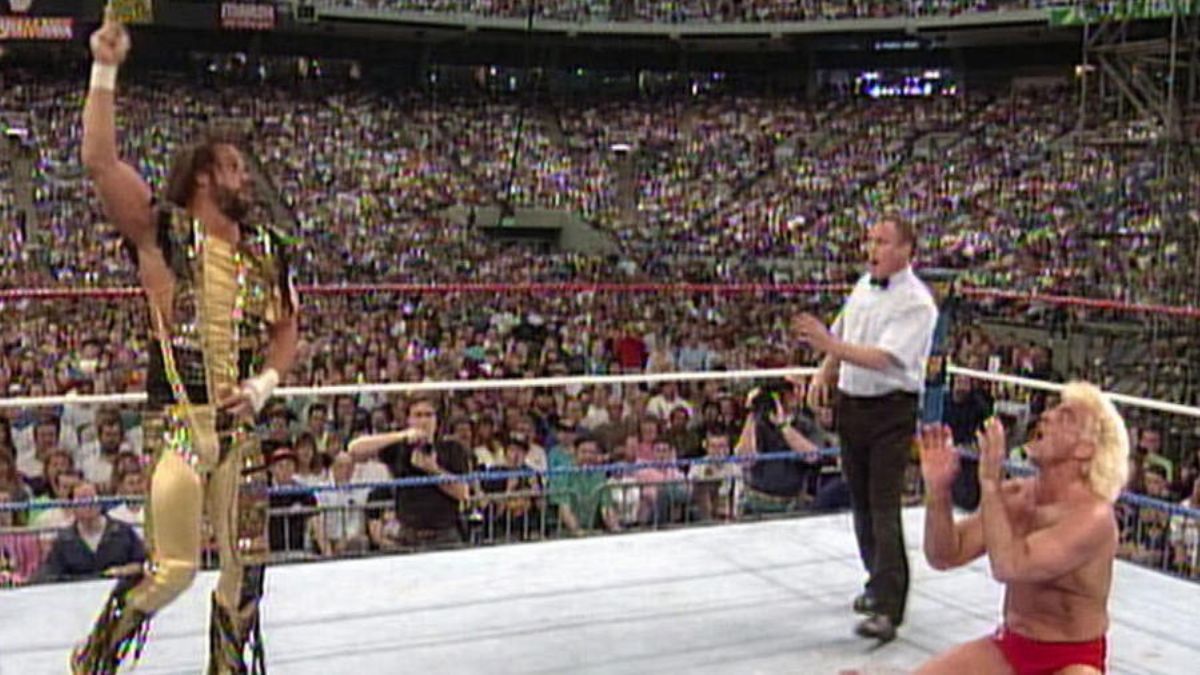
Randy Savage and Ric Flair at WrestleMania XIII.
Savage was apparently sensitive about being seen as ‘old’ in a young man’s game. This remained a sore point well after he left the WWF. Somewhere on YouTube you can watch a late-era promo where he rips into Triple H for calling him ‘dinosaur’. It’s not pretty.
It has never been totally clear whether Savage’s estrangement from the WWF/WWE was his doing or Vince McMahon’s. Both men were driven and known to hold grudges. One theory suggests that McMahon took word of Savage’s departure very personally. On hearing of Savage’s move to WCW during WWF’s time of crisis, McMahon banished Savage like Major League Baseball did Pete Rose. This rings hollow to me. Immediately after Savage’s departure was confirmed McMahon paid tribute to his former RAW broadcast colleague on-air. This was unheard of. Even Hogan’s departure had been ignored.
Savage left the WWF in 1994 and never came back. He signed with WCW for a good run and occasionally popped up elsewhere. He put out a rap CD, threatened a professional boxing career, appeared as the quote machine Bonesaw McGraw in the first Tobey Maguire Spider-Man movie, and had a match or two in TNA before leaving over a planned match finish. He seemed to settle into retirement, reconnecting with his high school sweetheart and marrying her shortly before passing away from a sudden heart attack in 2010. During his career Savage was known to be careful with his money. With extended runs on top of the WWF and WCW one would hope that by the time he retired he was set for a much longer life than he enjoyed. I hope that Savage simply realized that he didn’t need professional wrestling or WWE and moved on.
A less rosy version sees Savage carrying a grudge against McMahon and refusing to do business with him. As noted, Savage was upset by attempts to cast him as ‘old’ even while working for the WWF. When he left for WCW his former employer quickly aired skits depicting Savage and Hogan as feeble, senile old men — the ‘Huckster’ and ‘Nacho Man’ under the leadership of ‘Billionaire Ted’, a juvenile parody of WCW owner Ted Turner.
Former WWE executive Jim Ross has suggested on his Grillin’ JR podcast that Savage was difficult to work with. Savage’s in-ring perfectionism was well known, and often rubbed other wrestlers the wrong way. Ross has argued that once WCW ceased operations and with a surfeit of talent available, McMahon didn’t need feel the need to engage with a potentially disruptive talent.
The most salacious theory sees Vince McMahon blackball Savage from the WWF after he caught wind that the middle-aged Macho Man had an affair with a very young Stephanie McMahon. I include this story for completeness’ sake. Its chief proponent seems to be one of Savage’s ex-girlfriends. Stephanie Bellars, who worked with Savage as his valet ‘Gorgeous George’ in WCW has claimed that Savage disclosed his relationship with Stephanie to Bellars while they were both under the influence. Otherwise, these allegations exist mostly as anonymous reddit posts and backstage rumor and innuendo.
Unless better evidence is provided, I choose not to believe it. The timelines of the allegations have never been clear (which does make sense; an affair like this would have been kept private), and more credible wrestling insiders including Savage’s own brother, the late Lanny Poffo have disclaimed them.
Poffo was asked directly about the rumored affair in 2015, ahead of Savage’s posthumous induction into WWE’s Hall of Fame. Lanny Poffo gives his opinion on the Randy Savage & Stephanie McMahon affair rumour . Poffo stated that Savage was always concerned about his reputation, which would have been compromised had he engaged in an affair with his boss’ daughter. Poffo refused to speculate about a consensual, legal relationship between the two but he was sure that Savage would not have done anything illegal. Poffo suggested that those who are curious enough to pursue this line of reasoning ask Stephanie directly. So far as I know, she has never commented about the matter.
As poor as Savage’s relationship was with WWE, towards the end of his life there were signs that it was beginning to improve. Like most of the examples here, it seems WWE tried to rebuild this relationship — time just ran out. In 2010, WWE offered Savage a spot in its Hall of Fame. He declined, stating that he would only accept induction if the Poffos (including brother Lanny and father Angelo) joined the Hall as a unit like the Von Erichs or Funks. He did agree to allow WWE to use his likeness for video games going forward, similar to Bret Hart. Had he lived longer, I think a public reunion would have been likely. I also think that given Savage’s intense approach to the wrestling business it would have been brief.
Savage had apparently begun taping content for his own WWE video, which in many cases seems like a step on the path to wrestling reconciliation (or maybe that’s been overtaken by Network content or third-party documentaries; as I write this WWE has announced that it is ceasing production of DVDs and Blu-Ray discs).
As noted Savage was posthumously inducted into the WWE Hall of Fame in 2015 by his brother Lanny. When asked why he agreed to the induction despite the objections that Savage had voiced during his lifetime, Lanny framed his answer in terms of preserving Randy’s legacy and rewarding his fans.
MR. BOB BACKLUND
Bob Backlund’s exit from and return to the WWF is less notable for actual heat between wrestler and promotion and more for the massive shift in character that propelled him back into the main event.
One of the biggest victims of WWF’s transition from lucrative territory under Vincent J. McMahon to international entertainment company under Vincent K. McMahon, Backlund had been groomed by Vincent J. to be a long-term champion — an ‘All American’ good guy fighting off an endless series of foreign menaces and monsters.
Backlund followed a formula that had worked for previous champs Sammartino and Morales, with a difference. Sammartino was an Italian immigrant and Morales was Puerto Rican. Both were incredibly popular across the Northeastern United States, resonating within their own communities (which were large enough to constitute an impressive fan base) and beyond into other working class, immigrant and minority groups that made up New York’s melting pot and a sizable chunk of pro wrestling’s fan base. Backlund was popular as well, but in striving for a more universal hero as champ, Vince Sr. wound up with a great technical wrestler with an admittedly bland persona.
Bob Backlund at the Icons of Wrestling Convention & Fanfest on Saturday, March 26, 2022, at the 2300 Arena, in Philadelphia, PA. Photo by George Tahinos, https://georgetahinos.smugmug.com
Backlund won the WWWF title in 1978 and held it until 1983 by which point fans had largely turned on him over his apparent lack of charisma. The business was at a low ebb. One of the younger McMahon’s first orders of business on buying the now-WWF from his father was to move the title from Backlund to Hogan and let Hulkamania run wild.
Vince initially opted to do away with the usual transitional heel champion. He wanted Backlund to break bad and dye his hair black. According to his excellent autobiography, Backlund: From All-American Boy to Professional Wrestling’s World Champion Backlund refused, citing the bullying that his school-aged daughter would receive. Instead, Backlund lost the title in controversial fashion to the Iron Sheik, who in turn did the honors for Hogan three weeks later.
Lost in the new WWF with all of its pyro and ballyhoo, Backlund was immediately phased out of the title picture. He left the promotion altogether by August 1984. Apart from sporadic appearances for the AWA and Herb Abrams’ UWF, he mostly retired from professional wrestling.
But Backlund came back. He has said there was never enmity between him and McMahon; the business had just seemed to pass him by. In 1992, with Hulkamania waning and the WWF facing real life challenges, a squeaky-clean retro act like Backlund might prove desirable.
Or maybe not. Backlund’s return was exciting for older fans and those of us who joined the Hulkamania bandwagon but were curious about wrestling’s broader history, especially since the WWF had distanced itself from its past. For me, Backlund was fun to watch but his act had not aged well. Apart from his lack of flash Backlund’s return matches missed something. I imagine that it was his in-character insistence on sportsmanship. For fans conditioned on a generation of babyfaces like Hogan, who wrestled like heels when provoked (complete with eye gouges, back rakes and closed-fist punches, heaven forbid) moves like the Backlund Bridge pinning combination seemed anticlimactic. Backlund was still a great technical wrestler but some of his spots — like dropping an opponent from a wheelbarrow lift (itself a great feat of strength) into a full nelson rather than a match-ending slam read as a lack of killer instinct.
Backlund has acknowledged that his initial return just didn’t work. Fortunately, by this point his daughter was in high school and the likelihood of bullying had subsided. Presented with an opportunity to turn heel, Backlund enthusiastically agreed. In the summer of 1994 an objectively out of contention Backlund received a ‘pity’ shot at World Champion Bret Hart’s title on an episode of Superstars. The match received an uncharacteristic build for a syndicated show. For the first time Backlund’s backstory including the trauma of his loss to the Iron Sheik played out for a modern audience. The fact that Backlund had not submitted to Sheik’s finisher, the Camel Clutch, but lost because his manager Arnold Skaaland threw in the towel figured prominently in an sweet bit of foreshadowing.
Backlund lost his match against Hart, a victim of his own good sportsmanship.
Thus was born one of my all-time favorite heels.
When Bret tried to shake Backlund’s hand after the match and console him over his loss, Backlund snapped. He slapped Hart and procured his old crossface chickenwing finisher on the champion while screaming incoherently. Backlund eventually emerged from his feral state and stared at his hands, aghast at his actions.
This scene repeated itself over the next few weeks as Backlund attacked his opponents, backstage personnel and even his old manager, Skaaland. He continued trancing in and out until he embraced his dark side and went stark raving mad.
I’m a lifelong Hitman fan but this moment was awesome, laying bare the mad brutality that underlies a profession based on beating people up, no matter how ‘scientifically’ they may present themselves. Backlund’s crazed persona helped get the crossface chicken wing over as a feared submission instead of a boring technical hold. I still reference it … and use it on my kids when play-wrestling, complete with histrionics; my wife still loves me. Bob became ‘Mr. Backlund’. An avid reader and serial goal setter in real life, he busted out a vocabulary and knowledge of American history that would make Nick Bockwinkel jealous. Backlund’s references may have been factually and grammatically incorrect but he spoke his truth.
Backlund rode his new insane character to a November 1994 WWF championship victory over Hart. Ironically, Bret’s mother Helen threw in the towel after Bret was trapped in the chicken wing for almost ten minutes. Backlund’s reaction to his win was priceless. In a post-match interview he screamed how he felt “like God.” Mr. Backlund was nature, red in tooth and claw.
Backlund claims that he was originally supposed to enjoy a year-long title run. Plans changed and McMahon instead directed him to lose the belt three days later in convincing fashion to rising star Kevin ‘Diesel’ Nash. Backlund was disappointed but played ball. He sold the effects of Nash’s Jackknife power bomb all the way to the dressing room. He continued with WWE through 1996, although this run was more notable for his zany interviews and a sadly abandoned Presidential campaign (there have been worse Presidents since).
I am still shocked by how great Mr. Backlund’s character was and look forward to his televised appearances some 30 years later. His unhinged persona showed a completely different side of Backlund that reveled in the fun of pro wrestling as pure, unrestrained id. If Backlund had the opportunity to showcase this side of himself during his initial run — or had taken McMahon up on his offer of a heel turn in the ’80s, I wonder whether an eventual return to babyface status might have catapulted him to new heights. I know I would have loved it.
SGT. SLAUGHTER
If you, like me, were caught up as a kid in wrestling’s 1980s explosion in popularity, you likely remember that while Hulk Hogan was the WWF’s biggest star, he had his share of competition. Hogan had an able supporting cast of babyfaces including the likes of Tito Santana, Jimmy ‘Superfly’ Snuka, Andre the Giant and the Junkyard Dog. Most of these wrestlers’ popularity came close to Hogan’s, but rarely threatened to eclipse it. The one wrestler who rivalled Hulkamania’s popularity was Robert ‘Sgt. Slaughter’ Remus.
Trained by Verne Gagne, Slaughter had been wrestling for over a decade by the time the Rock ’n’ Wrestling connection was born. He worked a succession of gimmicks across the territories, including under a mask as Super Destroyer Mark II, before hitting on a Marine Corps Drill Instructor gimmick. Coming on the heels of the hugely unpopular Vietnam War and movies like Apocalypse Now, which painted the US military in a highly unflattering light, Slaughter’s character was a vicious heel. So much so that in a 1980-81 WWF run he turned fellow heel Pat Patterson face and wrestled a hotly contested series against then-champ Bob Backlund.
Public sentiment shifted as the ’80s moved on. World events like increasing enmity between the US and the Soviet Union and Iran’s growing belligerence as it turned into a theocracy and took Americans hostage led many to rally around the US flag. Slaughter changed with the times. He became a hero in 1984 and launched into a feud against the hated Iron Sheik.
Slaughter was red hot. And then he was gone, banished to the increasingly irrelevant AWA.
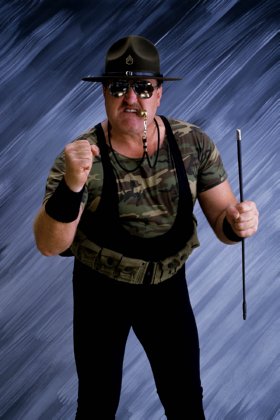
Sgt. Slaughter in his prime.
There are several competing theories as to why Slaughter left the WWF with his stock on the rise. The earliest one I remember hearing was that the WWF was threatened by Slaughter’s sudden popularity and got rid of him to focus fans’ attention on Hulk Hogan.
As a law student I once tried writing a term paper on the prospects for unionization in professional wrestling and reached out to journalist Dave Meltzer. I doubt he remembers the exchange but I do. I raised this theory and he politely dismissed it. As Mr. Meltzer understood (to my recollection), Slaughter was canned for attempting to organize the talent backstage and push for a wrestlers’ union.
Slaughter himself has claimed that he was fired after no-showing a date in Toronto in protest over being denied a request for paid vacation.
Yet another version ascribes his firing to a dispute between Slaughter and the WWF over the use of his likeness in the GI Joe toy line and cartoons at the same time as the WWF was embarking on its own line of LJN projectiles/action figures. If you’re into wrestling collectibles, you’re likely aware that unproduced or limited-run Sgt. Slaughter figures command a premium.
Slaughter spent five years in Gagne’s AWA. Like Hogan before him, Gagne treated Slaughter as a popular attraction but refused to make him the focus of the promotion. Instead the AWA World Heavyweight Championship bounced between the likes of Rick Martel, Stan Hansen, Nick Bockwinkel, Curt Hennig and Larry Zbyszko as it faded into irrelevance. The WWF attempted to replace Slaughter with the ripoff Corporal Kirchner character. Kirchner got his LJN figure. At some point Slaughter sought to mend fences and wrote to McMahon directly to congratulate him on the WWF’s success.
Slaughter returned to the WWF in 1990 and enjoyed his most successful run. Allegedly handpicked by Hogan as an eventual WrestleMania opponent, Slaughter’s return pivoted away from his GI Joe babyface character. At first he returned to his old heel drill sergeant routine (complete with new ‘noogie’ finishing hold). Later, with the prospect of real conflict with Iraq looming he became an Iraqi sympathizer heel flanked by actual Iraqi-born General Adnan (himself a former WWWF tag team champion as Indigenous superstar Billy White Wolf) and longtime nemesis the Iron Sheik as Colonel Mustafa (I get the need for reinvention, but that one never made sense — Sheik was well known to audiences, he had been a frequent opponent of Slaughter’s, and given the near constant real-life wars between Iran and Iraq his participation in this faction would have made him as much a traitor as Slaughter).
Looking back on it, it was a silly, grossly distasteful gimmick and storyline. But it got Remus a world championship run even if it tainted a truly beloved character. Slaughter himself is said to have struggled with the character change, especially the part where he sided with America’s enemies.
In recent years Remus has come under fire for appropriating military identifiers throughout his career. It has been claimed that ‘Sgt. Slaughter’ is stolen valor, the term for civilians who pretend to military service, which is seen as shameful. Remus has defended his character. In his mind, Robert Remus was always a civilian, but Sgt. Slaughter — the character he played — was a military man. The idea that wrestlers are somehow uniquely accountable for the characters they play outside the arena is a particular part of kayfabe. In any case Slaughter felt uncomfortable during his heel championship run, especially when fans saw fit to threaten his family over his ‘desertion’.
THE RIGHT OF RETURN
The stories above and their outcomes vary considerably depending on where a given wrestler was in their career at the time of their break from WWE, their options until they returned, and their condition once they came back.
In some cases (like Punk’s, I hope) a wrestler will come back to a hero’s welcome and are able to contribute at a high level for years, resuming their championship caliber careers and cementing their legacies.
In other cases wrestler and promotion work around each other to craft shorter fan-service runs; the ‘one more match’ that fans think they want, or longer programs that accommodate their limitations.
Some wrestlers only come back once their in-ring careers are finished, but still get the send-off they deserve since sending the fans home happy is pro wrestling truism.
The worst case comes when the rapprochement comes too late. A wrestler’s legacy may be honored, but they’re not around to enjoy it.
Like I said last week, I’m happy that CM Punk has found his way back to WWE, whatever his reasons. I am encouraged by a pattern whereby WWE seeks reconciliation with its top talent and hope that some day this approach extends to other talent. More importantly, I hope that these comebacks spark a recognition of the need for WWE and other promotions to treat their performers and fans with respect.
TOP PHOTO: CM Punk on Friday Night Smackdown on Dec. 8, 2023. WWE photo
RELATED LINK
